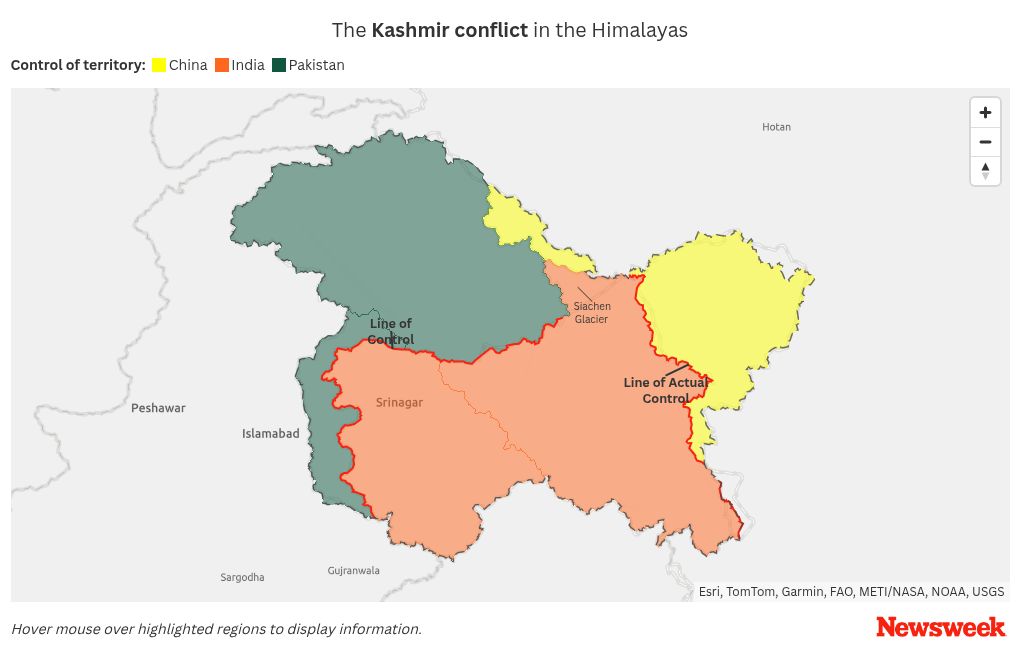Escalating hostilities between nuclear-armed neighbors India and Pakistan—a close strategic ally of Beijing—may be serving as a testing ground for Chinese defense technology.
This would include the first “kill” ever by the Chengdu J-10C multirole fighter, a Chinese-built jet Pakistan said shot down Indian air force fighters Wednesday.
Newsweek reached out to the Indian, Pakistani and Chinese foreign ministries with emailed requests for comment outside of office hours.
Why It Matters
India on Wednesday launched “Operation Sindoor,” a coordinated series of strikes on what it described as terrorist infrastructure in Pakistan and Pakistan-administered Kashmir. The campaign followed a deadly April 22 mass shooting in disputed Kashmir that killed 26 civilians.
The fighting has included one of the largest aerial engagements between the two countries in recent memory. A Pakistani official said more than 100 aircraft were involved in a dogfight that lasted over an hour, in what would be one of the largest air battles since World War II.
What To Know
Pakistan claimed it shot down five Indian planes: three French-made Rafale fighters, a Russian-designed MiG-29, and a Russian Su-30. Deputy Prime Minister Ishaq Dar said J-10C jets were used in the operation.
If confirmed, it would mark the first time plane in the 27-year-old J-10 family has seen combat—and the first time the capable Rafale has been shot down in battle.
The South Asian country, “which Beijing has dubbed an “all-weather” ally, is the only country other than China to operate the J-10.
India has denied losing aircraft. The c36ountry’s state-run Press Information Bureau said an image Pakistan circulated of a damaged Rafale was from an earlier unrelated crash. The Indian Embassy in China called the claims “disinformation.”
Pakistan fields around 20 J-10C jets and has ordered 36 more. The aircraft is produced by Chengdu Aircraft Corporation and equipped with modern radar and air-to-air missile systems.
After the fighting, shares in Aviation Industry Corporation of China (AVIC), the parent company of J-10C manufacturer Chengdu Aircraft Corporation, rose 1.6 percent on Wednesday—reaching a two-week high—on news of the border clashes, according to Bloomberg.
India also said it had struck Pakistani air defense systems during the operation. Indian media, citing defense sources, reported that Pakistan’s HQ-9P and HQ-16 surface-to-air missile platforms—supplied by China—were destroyed during strikes near Lahore. No missile interceptions were reported.
The HQ-9P is a shorter-range export variant of China’s domestically deployed HQ-9 system. China’s version has a reported range of more than 155 miles. Pakistan’s version is estimated to cover about half that distance.

India operates the Russian-made S-400 Triumf missile defense system and remains one of Russia’s largest arms buyers, though its government is expanding local production under the Make in India initiative.
The conflict poses a delicate balancing act for the United States.
Pakistan is a longtime security collaborator, while Washington’s strategic partnership with India has grown in importance amid U.S. efforts to counter China’s rising military power in the Indo-Pacific region.
Both India and Pakistan claim a portion of Himalayan region. China holds a smaller tranche of the territory.
What People Are Saying
Sajjan Gohel, international security director at the London-based Asia-Pacific Foundation think tank, told CNN: “This makes any engagement between India and Pakistan a de facto test environment for Chinese military export.”
Lin Jian, Chinese Foreign Ministry spokesperson, told reporters Thursday: “India and Pakistan are and will always be each other’s neighbors. They’re both China’s neighbors as well. China opposes all forms of terrorism.
“We urge both sides to act in the larger interest of peace and stability, observe international law, including the UN Charter, remain calm, exercise restraint and refrain from taking actions that may further complicate the situation.”
What Happens Next
The tit-for-tat conflict marks the most-serious clash between the South Asian rivals since 1999, and it’s unclear how much further it could escalate.
The U.S. and other countries have issued calls for restraint and encouraged both sides to de-escalate through diplomacy.
Update 5/10/25, 4:10 a.m. ET: This article has been updated with additional information.
The post India-Pakistan War: Chinese Weapons Get Combat Test appeared first on Newsweek.




